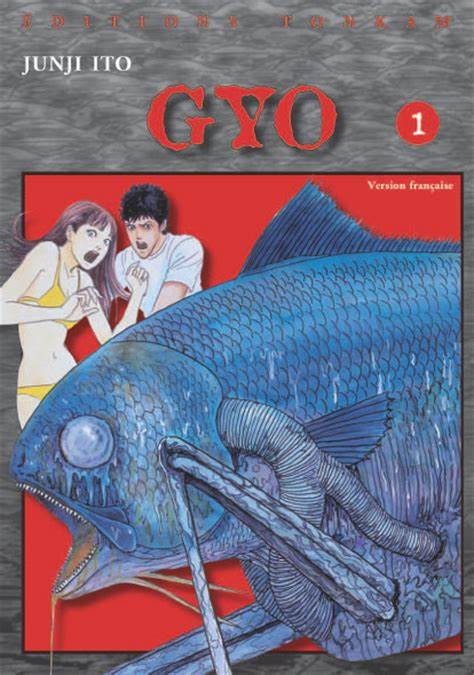Manga Review: Gyo by Junji Ito
Tadashi and Kaori, a handsome young couple, thought a vacation by the sea would be an excellent idea. That’s why they’re in Okinawa, living in his uncle’s seaside home and diving off his boat. One day while SCUBA diving, Tadashi comes across a wrecked battleship on the ocean floor. He doesn’t get too good a look, as first a scarily fast small fish, and then sharks come ominously near. The sharks pursue Tadashi, but he gets back on the boat in time. Good things sharks can’t come out of the water!

Back at the house, Kaori’s keen nose senses a foul odor, something like rotting flesh. At first she thinks it’s a hygiene failure on Tadashi’s part and the couple quarrel. Too soon, they discover that the stench is coming from a fish. A fish with legs, scuttling about on land at a speed unlikely even if fish normally had legs. After some scary minutes, Tadashi manages to smash the creature and imprison it in a plastic garbage bag.
That’s just the beginning of their woes, as Okinawa in general is soon experiencing an invasion of “walking fish” of many species, up to and including great white sharks! Can Tadashi and Kaori survive? Can anyone?
Gyo (“fish”) is one of famed horror manga creator Junji Ito’s longer works. While it takes a lot of turns, it’s much more of a connected plotline than most of his series, which have more of an “anthology on a theme” feel. Each bizarre, unsettling development feeds into the next, moving from a single nightmarish fish out of water to the final apocalyptic landscape of moving death.
Tadashi’s uncle, research scientist Dr. Koyanagi, gives at least a partial explanation for the phenomenon, linking it back to Imperial Japan’s biological warfare experiments, which his own father was tangentially involved with. But that still leaves a lot of blanks unfilled, and there may be something supernatural going on as well, as a circus Tadashi encounters towards the end suggests.
Kaori’s name means “fragrant” or “good-smelling”, which becomes increasingly inappropriate as the story wears on. She’s not a likable person, giving to whining and complaining when not shrieking in terror and being all around useless. Partially as a result, Tadashi tends to ignore or dismiss her ability to smell death coming. Not that it would have done much good if he’d paid attention. Her fate is cruel indeed.
Tadashi himself is more of an average dude protagonist–he scores a few small victories, early on, but is in no place to affect the overall outcome of the story, and winds up more as a witness to the disaster.
The art is excellent, as usual for Ito’s work, with him clearly enjoying creating the freakish monsters overrunning Japan. His limited supply of attractive female faces doesn’t cause much problem here due to the small number of main characters.
The combined edition I read also includes two independent stories. “The Sad Tale of the Principal Post” is a short short in which a new homeowner is found trapped under the “principal post” of the house, with no indication of how he got there. It’s okay. “The Enigma of Amigara Fault” on the other hand is one of Junji Ito’s most famous stories. An earthquake exposes a stone incline in the mountains that has curiously human-shaped holes in it. Holes that are just the right size and shape for certain people to get inside. They don’t seem to be coming out, either. The ending image is…unsettling. Drr…drr…drr…
Content note: Lots and lots of body horror. People and animals die, some of them quite messily. Nudity, initially barbie doll fanservice, but later the nudity of bloated corpses. This is not a series for people with delicate stomachs and I’d suggest older teens at minimum.
Junji Ito knows how to take a simple idea like “wouldn’t it suck if killer sharks had legs?” and introduce even nastier twists to go beyond ordinary horror. Highly recommended for the kind of reader who enjoys this sort of thing.

